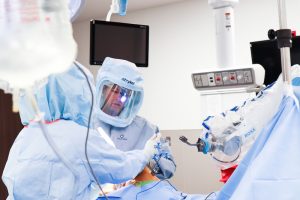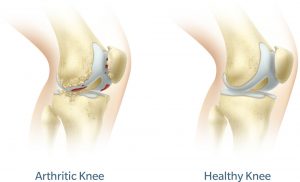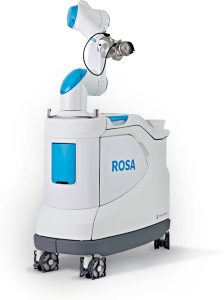Orthopedic surgeons and the medical staff at Coryell Health Minimally Invasive Surgery Center offer an orthopedic robotic knee system, which brings together robotic technology with industry-leading knee implants to help surgeons personalize surgical procedures for their patients. Coryell is the first to use x-ray guided orthopedic robotic technology in the Central Texas area. The ROSA (Robotic Surgical Knee is a robotically-assisted surgical system designed to help perform total knee replacement surgery. It includes features to assist with bone resections and assessing the state of soft tissues in order to facilitate implant positioning intraoperatively. Data provided by orthopedic robots assist with complex decision-making and enables surgeons to use computer and software technology to control and move surgical instruments, allowing for greater precision and flexibility during procedures.

“For everyone involved – surgeons, medical staff and, most importantly, patients – the orthopedic robot has the potential to offer a number of key benefits and advantages,” Jacob Battle, MD, Coryell Health Orthopedic Surgeon said. “The orthopedic robot provides us with data throughout the surgery to help us know how to position your implant based on your unique anatomy. It really personalizes the approach to total knee replacement. We know the decision to have joint replacement is often a difficult one for patients to make, and we believe these robotically-assisted technologies have the potential to make it an easier one moving forward.”.
For more information on how patients may benefit from a knee replacement at Coryell Health, contact our medical clinic at (254) 865-2166.

Understanding robotic technology for total knee replacement
You’re unique, and so is your individual anatomy. That’s why Zimmer Biomet offers ROSA® Knee robotic technology. ROSA, which stands for Robotic Surgical Assistant, is designed to help your specially trained surgeon tailor the placement of your knee implant just for you. Here, we will explain what makes the ROSA Knee System unique, what to expect preoperatively, what will happen with ROSA Knee during surgery and what to expect after your surgery.
Arthritis in the knee joint
 The knee is a hinge joint formed by the tibia (shinbone), femur (thighbone) and patella (kneecap). The ends of the bones in the knee joint are covered with cartilage, a tough, lubricating tissue that helps cushion the bones during movement.
The knee is a hinge joint formed by the tibia (shinbone), femur (thighbone) and patella (kneecap). The ends of the bones in the knee joint are covered with cartilage, a tough, lubricating tissue that helps cushion the bones during movement.
Osteoarthritis, the most common form of arthritis, is a wear-and-tear condition that destroys joint cartilage and bone. It typically develops after years of constant motion and pressure in the joints. As the cartilage continues to wear away, the joint becomes increasingly painful and difficult to move. If conservative treatment options fail to provide relief, your surgeon may recommend total knee replacement using ROSA Knee robotic technology.
ROSA Knee Robotic Technology
 Getting a precise knee implant fit is important to your comfort and overall experience following knee replacement surgery. ROSA Knee uses data collected before and during surgery to inform your surgeon of many details related to your unique anatomy that may affect your implant fit. By using this data to make more informed decisions, your surgeon is able to plan for and carry out a personalized surgery based upon your individual needs.
Getting a precise knee implant fit is important to your comfort and overall experience following knee replacement surgery. ROSA Knee uses data collected before and during surgery to inform your surgeon of many details related to your unique anatomy that may affect your implant fit. By using this data to make more informed decisions, your surgeon is able to plan for and carry out a personalized surgery based upon your individual needs.
Before surgery
Your preoperative experience will be like that of most total knee patients. But, unlike traditional knee replacement methods, with ROSA Knee, a series of x-rays may be used to create a three-dimensional (3D) model of your knee anatomy. This 3D model will enable the surgeon to plan many specifics of your knee replacement prior to your surgery.
During surgery
The surgical procedure using ROSA Knee is similar to traditional total knee replacement, but with a robotic assistant. Your surgeon has been specially trained to use ROSA Knee in order to personalize the surgical approach for your unique anatomy. It’s important to understand that the robot does not operate on its own. That means it does not move unless your surgeon prompts it to. Your surgeon is still in the operating room the entire time and is making all of the decisions throughout your surgery.
During your procedure, ROSA Knee utilizes a camera and optical trackers attached to your leg to know exactly where your knee is in space. Think of it like a very detailed global positioning system (GPS) that you might use in your car. If your leg moves even a fraction of an inch, the robot can tell and adjusts accordingly. This helps ensure that the plan your surgeon put into place is executed as intended. Throughout your surgery, ROSA Knee provides your surgeon with data about your knee. This information, combined with your surgeon’s skill, helps them know how to position your implant based on your unique anatomy.
After surgery
Following surgery, you will be hospitalized based upon the recovery plan your surgeon decides is best for you. This hospitalization may range from one to three days. Recovery time varies, but most people should be able to drive after two weeks, garden after three to four weeks, and golf after six to eight weeks. Your surgeon will tell you when and what activities you can return to, and what activities to avoid.
Complications
While uncommon, complications can occur during and after surgery. Some complications include, but are not limited to, infection, blood clots, implant breakage, malalignment and premature wear, any of which can require additional surgery. Although implant surgery is extremely successful in most cases, some patients still experience stiffness and pain. No implant will last forever, and factors such as your post-surgery activities and weight can affect longevity. Be sure to discuss these and other risks with your surgeon.
There are many things that your surgeon may do to minimize the potential for complications. Your surgeon may have you see a medical physician before surgery to obtain tests. You may also need to have your dental work up-to-date and may be shown how to prepare your home to avoid falls.
Summary
The decision to have surgery is sometimes difficult. We hope that this information has helped you understand the ROSA Knee System so that you can make the best decision for yourself. This information is not intended to replace the experience and counsel of your orthopedic surgeon. If you have any further questions, please speak with your orthopedic surgeon.

Featured Blogs
Coryell Health Offers Orthopedic Robotic Surgery
Orthopedic surgeons and the medical staff at Coryell Health are excited to offer an orthopedic robotic knee system, which brings together robotic technology with industry-leading knee implants to help surgeons personalize surgical procedures...
Minimally Invasive Surgery
At its very core, performing a successful surgical procedure is about art, skill, and precision, all of which can be supported and advanced by the latest technologies. At Coryell Health...
Can Vitamins Help Minimize Your Knee Pain?
Take a stroll down your grocery store’s pharmaceutical aisle and you’re sure to see them. Hundreds of bottles of dietary supplements—vitamins, minerals, herbs and amino acids—line the shelves at most...
 Skip to content
Skip to content
